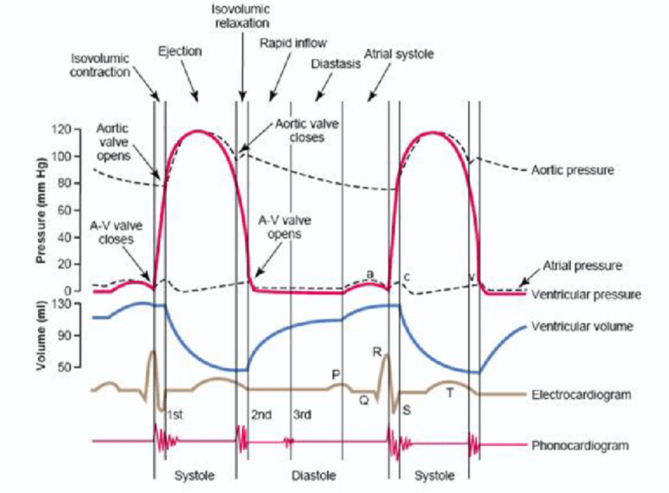2019 - Multiple Choice Questions
What is the pKa of the phosphate buffer system?
- pKa 6.1
- pKa 6.8 Signifcant in ICF & urine
- pKa 7.4
- pKa 8.1
The sodium concentration in 0.9% (Normal) Saline is approximately:
- 115 mmol/L
- 128 mmol/L
- 130 mmol/L
- 150 mmol/L
The arteriovenous oxygen concentration difference is GREATEST for the:
- Brain
- Heart
- Liver
- Lungs
During the cardiac cycle, aortic valve closure coincides with:
- The beginning of isovolumetric relaxation
- The ‘c wave’ of the central venous pressure trace
- The first heart sound
- The ‘T wave’ of the electrocardiograph (EGG)

Lactate produced during strenuous exercise is predominantly:
- Converted to acetoacetate in muscle
- Converted to glucose in the liver (Cori Cycle)
- Converted to pyruvate in muscle
- Converted to urea in the liver
The measured peak end tidal CO2 (PETCO2) is normally:
- At the end of phase II on a typical capnograph
- Detected using side-stream or main-stream Doppler sensors
- Higher than measured PaC02 when PEEP is applied during SIMV
- Lower than PaC02 due to dead space
Which of the following has the LEAST mineralocorticoid activity?
- Aldosterone
- Cortisol
- Dexamethasone
- Prednisone
What is the mechanism of action of vancomycin?
- Inhibition of bacterial cell wall synthesis
- Inhibition of bacterial DNA synthesis
- Inhibition of bacterial ribosomes
- Inhibition of beta-lactamase
Metabolic effects of adrenaline on the liver include the stimulation of:
- Gluconeogenesis
- Glycogenolysis
- Protein synthesis
- Triglyceride synthesis
Glycogenolysis
And Gluconeogenesis…
Metabolic effects of Cortisol include:
- Increased inflammatory mediator production
- Increased protein synthesis
- Inhibition of fatty acid oxidation
- Stimulation of gluconeogenesis
Normal cerebral blood flow in mL/100g brain tissue/min is approximately:
- 20
- 50ml/100g
- 85
- 420
The following is an example of a prodrug:
- Enalapril
- Hydralazine
- Metoprolol
- Nifedipine
Growth hormone:
- Increases osteoblast activity
- Is a steroid hormone
- Is released evenly during a 24-hour period
- Reduces fatty acid secretion
Renal blood flow:
- Is about 600 ml/min per kidney
- Is directly measured by infusing para-aminohippuric acid (PAH)
- Is increased by sympathetic tone
- Per gram of tissue, is the highest blood flow of any organ
To which of the following side effects of opioid analgesics does tolerance MOST develop?
- Bradycardia
- Constipation
- Miosis
- Nausea and vomiting
With reference to benzodiazepines:
- A single dose of midazolam has a quick offset of action due to rapid renal clearance
- Diazepam undergoes hepatic metabolism to active desmethyldiazepam
- Flumazenil is a non-competitive antagonist competitively inhibits
- Lorazepam has a short duration of action
Dobutamine:
- Decreases urine output
- Has a half-life of 45 minutes
- Increases atrioventricular nodal conduction velocity
- Is a selective alpha agonist
Type I hypersensitivity:
- Involves production of IgG and IgM
- Involves Th1 and CD8+ bearing cells
- Is associated with increased vascular permeability and vasodilation
- The prototype is autoimmune haemolytic anaemia
Adrenaline is secreted by the:
- Adrenal medulla
- Zona fasciculata of the adrenal cortex
- Zona glomerulosa of the adrenal cortex
- Zona reticularis of the adrenal cortex
What hormone do the D (delta) cells of the pancreas secrete?
- Glucagon
- Insulin
- Pancreatic polypeptide
- Somatostatin